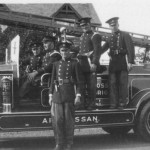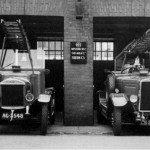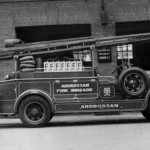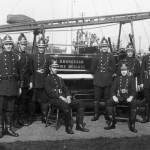History of Ardrossan Fire Brigade
January 1938
Contributed by George McGrattan ~ Ardrossan
Appliance Photographs
Foreword
This book has been written to meet a definite need and also in fulfillment of the strong wish of many persons who are concerned with the protection of the community against the constant and insidious danger of fire. The prevention and extinction of outbreaks of fire has become a highly technical and complicated business, and the fireman of today requires, not only intensive physical training, but also a great deal of scientific instruction. He has to face dangers and difficulties which were not even dreamed of fifty years ago on account of the great changes which have taken place in architecture and the presence even in ordinary dwelling houses of explosive and inordinately inflammable substances, of electric currents and of obstacles that can only be removed by a skilled engineer.
The Fireman just as much as the sailor and soldier, has to be trained for "chemical warfare" and his business is not only to save property but even more to save life. For the latter purpose he has to be carefully instructed in First Aid and Ambulance work, besides being taught the use of a great deal of complicated apparatus for fire-fighting. The Fireman's vocation has, therefore, become in an ever increasing degree an art and science.
Peter DUNN (Firemaster)
Fire Station Ardrossan.
Ardrossan was formed a burgh in the year 1846 and it is of interest to follow the fire precautions that were taken by our civic forefathers. Pont. The Historian wrote about the first recorded fire in Ardrossan:
The Castle was in the hands of the English and Wallace, using strategy set a house hard by the castle on fire, and those who kept the castle came out unsuspecting to help to the rescue, but Wallace with a well armed company gave them a hot welcome and killed every mother's son and forced the Castle.
Fire plugs were first laid in Glasgow Street, Ardrossan in 1865. We read in the minutes of the Town Council of date 3rd July, 1865:-
"The Town Council agreed to have offsets suitable for Fire Plug Cocks put upon the new Main Pipe which the Water Company are about to lay in Glasgow Street, and that the Water Company be requested to put in eleven branches of offsets of such construction as would suit for attaching fire plug cocks."
Four years later, February, 1869, the Town Council began to think of providing a fire engine for the use of the Burgh. "At a meeting of the Town Council Provost moved that the Works Committee be appointed to enquire as to the price of fire plugs and what number they would recommend for the Town and also to enquire as to the cost of a Fire Engine."
Accordingly at a meeting held on the 4th June, 1869. Provost Barr produced drawings and prices of Fire Engines by London and Glasgow makers and it was agreed to recommend the "Patent Curricle Fire Engine" made by Shand Mason and Co., London. Of the size suitable for Twenty two men to work, price Seventy Three Pounds Sterling complete with hose, implements, etc., as specified in printed list. The Committee also agreed to recommend the pattern of Fire Plug Cocks as made by Thomas Leadbetter & Co., Glasgow or the number I.C. (?) pattern made by Glen field Company, Kilmarnock which the Committee understood are the same kind of Cocks on the Ardrossan Harbour.
Chamber's describes "curricle" as a two wheeled open chaise drawn by two horses abreast: a chariot.
The destruction and danger from fire was early appreciated by our early Fathers, and no doubt tires of a more or less serious nature must have occurred in Ardrossan to have caused such precautions being taken. We read in the minutes of the meeting 1869:
"Referring to a fire in Princes Street into a mean Gable between Captain Blackley and Mr Paton. Troon, the Clerk was instructed to write these gentlemen drawing their attention to the state of the chimney heads and cans." It was earlier apparent that the new Fire Engine which was worked manually by the twenty two men was to prove unsatisfactory for we read in the minutes for April 1870." It was reported that a further trial of the Fire Engine had been made with the full compliment of men engaged and wrought up to sixty strokes per minute and the smallest of the pipes attached and the result was that the engine only threw the water to a height of sixty feet."
How long How long the full compliment of men maintained the sixty strokes a minute is not stated but it is presumed that other twenty two men were ready to relieve them otherwise they very soon would have been exhausted.
From the very beginning of the Fire Brigade in Ardrossan it appears that Mr William Young. Engineer, took full control and charge of same. When the new Fire Engine came to the town it appears to have been first kept in his premises at the Harbour and that it was his own workmen who assisted with the Fire Brigade. Later, the Fire Engine was housed at the Market in Harbour Street. Apparently there were two such Fire Engines in Ardrossan, one of which belonged to the Ardrossan Harbour Company and both of these machines attended fires within the Burgh although it must be truthfully said that they were of little use. When new water pipes were laid throughout the town and hydrants were attached to same it became early apparent that it was easier and more efficient to work with hose direct from the hydrant rather than use the cumbersome manual pumps for in March, 1874. Mr. Young submitted the following report on the Fire Brigade to the Town Council: "I believe eight good men who are likely to be most permanent in the town would form a standing Brigade quite equal to requirements of the place. I would propose that these eight be paid five Shillings every time they are in practice, and this I would recommend should be three times a year. The duties of the Brigade in these times would include taking out the engines, working them for a short time at some convenient place cleaning and oiling them and overhauling the hose and putting everything in proper order for any emergency, and also at the same time examine every Fire Plug in the town to make sure none of them are covered up, and that they are in good working order, and to facilitate matters in this respect as well as in the case of fire I would recommend that letters should be painted on the walls indicating their position".
It would have been impossible to work the manual pumps with only eight men and it must be presumed that when they were brought out to attend fires only the hose and other fittings were used, the labourous pumping apparatus being left untouched
Under the present Acts which govern fire brigades local authorities have no powers to make charges for services rendered within their own boundary where it is rated, but it seems that under the old Burgh Act they had powers to make such charges. The minutes of 12th March, 1874 reads. "The meeting first took into consideration the fixing of a charge in connection with the use of the Fire Engines when it was agreed to recommend that the Engines should not be brought out under a charge of £5 each, the commissionaires reserving the right to claim the full sum of £15 under section 126 of the Burgh Act as circumstances may direct, and if the Engines were required outside the Burgh an extra charge for conveyance and otherwise be made."
The Burgh assessment for the year 1876 was fixed at One Shilling per Pound.
In September, 1874 we read of Mr Young being officially termed the Superintendent of the Fire Brigade which position he filled voluntarily and without remuneration, and a Deputy together with six men were appointed:
William Young Superintendent of the Fire Brigade.
Thomas Heald. Jnr., Deputy, 21, Glasgow Lane.
James Dawson, Harbour Place
William Wallace, 90, Glasgow Street.
John Loudon, Harbour Place.
Archibald Robertson, 15, Glasgow Lane.
Jon McCormick, 83 Glasgow Street.
John Thorburn, 91, Glasgow Street
(I regret that I can find no photographs neither of the old crew nor of the old Manual Fire Engines)
Mr Young who had taken control of the Brigade since its inception, and who had shown much enthusiasm in his work retired from the position in October 1884. Thomas Heald, deputy Superintendent also retired at this time. Mr Young later became a member of the Town Council and continued to take an active interest in the Fire Brigade. Thomas Wallace Engineer Glasgow Street, was appointed Superintendent of the Fire Brigade to succeed Mr. Young. In November, 1884, but in December five years later namely 1889 the Town Council decided to appoint Mr William Balmer Water Manager, to be Superintendent of the Fire Brigade whose knowledge of the fire plugs and water supply generally will be so serviceable in such a consideration.
This goes to further prove that the Fire Brigade preferred too work from the fire hydrants rather than use their manual pumps.
It is of interest to read that in February 1896 a letter was submitted to the Town Council from the Burgh of Kinning Park asking the Commissionaires to support a bill to be introduced in Parliament for the purpose of enabling Burgh Commissionaires to make a charge for Fire Brigade services against the owners and occupiers of premises where fire may occur such as had been provided for in the Police Act of 1862. It was agreed to petition in favour of the Bill. The present Burgh Police Scotland Act of 1892 under which most Brigades in this country are administered by does not permit of charges being made for service at fires within the rated area of the local authority.
After the serious fire at the Caledonian Railway Station the Fire Brigade again was reorganised and we read in the minutes of the Town Council of 13th April, 1899. "The Committee having given the matter of the re-organisation of the Fire Brigade their best consideration resolved as follows:
1st. That the Brigade consists of eight members
2nd. That the Water Manager be no longer a member of the Brigade, but that the allowance of £5 per annum hitherto paid to him as Superintendent be continued in consideration of which he was to attend practices and turn on from the mains such pressure as the Firemaster (this is the first time this title is used) or deputy may require.
In February, 1899, the following appointments to the Fire Brigade were made:
Firemaster: Finlay Murchie
Deputy: James Allison.
Firemen: William Hunter; John Gibson; John Wilson; John Gemmell; James Dimmick; and Gilbert Lewis.
On the 14th October, 1901, in a report to the Town Council. "The Superintendent gave his assurance that on the occasion of a recent fire the Brigade had turned out promptly and were all in the Engine House within fifteen minutes of being warned by the Police, which was considered quite good and in view of the slow method of calling the Brigade at that time the Police called at each individual's house it undoubtedly was.
Firemaster Finlay Murchie retired from his position about March, 1926, having been in charge of the Fire Brigade for over 27 years, and it is of interest to note that his son, John Hunter Murchie is at present Third Officer of the Fire Brigade.
Mr James H. Griffin, Burgh Officer was appointed Firemaster to succeed Findlay Murchie and which position he held until Mr peter Dunn, Paisley Fire Brigade was appointed on the 18th October, 1928.
About this time 1928 the members of Ardrossan Town Council had been giving the question of better fire protection their serious consideration.
A meeting was held with the appropriate committee of Saltcoats Town Council on the subject of a joint fire service, but little came of it and Ardrossan Town Council after the serious fire in the Bonded store, July, 1928 ordered a Motor Fire Engine from Dennis Brothers. Guildford, with a pumping capacity of 250 400 g.p.m., and also decided to appoint a Firemaster to re-organise the Brigade. Accordingly the present firemaster Mr. Peter Dunn, who was a member of Paisley Fire Brigade was appointed. As the members of the brigade were scattered all over the town the most difficult problem that faced the new Firemaster was the calling of the men when required. This was solved by running a system of fire alarm wires to each individual member's house installing a powerful alarm bell in same.
Appliances In use in 1938
Dennis purchased 1928 350-400 g.p.m
Leyland purchased 1928 400-600 g.p.m




The new Fire Engine was housed temporally in a large shed in the Burgh Yard and it is of interest to note that by the new system of bell call the Brigade's average time for turning out night or day was six minutes. On January, 1930, an agreement was made for the protection of the Burgh of Kilwinning and since that date the Brigade has been responsible for the extinction of all outbreaks of fire within the Burgh. The management has been most satisfactory to both authorities. Kilwinning Town Council pay £75 annually for all services. No further charge being made. The sum of £75 in 1930 represented almost 3/4d on the rates of Kilwinning.
In the year 1933 an agreement was made with the representative of the West Kilbride and Fairlie Ratepayers Association with the Town Council whereby for the sum of £12 they would have a guarantee of service of the Fire Brigade when called on. The usual charges for country fires to be paid by the owner or occupier concerned. At the end of that same year 1933, Ardrossan Town Council decided to build a new Fire Station with all modern conveniences.
On the 14th July, 1934, it was opened by Sir N.K. Cochran-Patrick. Convener of Ayr County Council. The station has accommodation for two motor pumps and housing for two officers and eight men. The accommodation for the officers comprises four apartments; kitchenette, bathroom and access to the station, in addition to the domestic stair, by means of poles. The other houses comprise of a living room, two bedrooms, kitchenette and bathroom. There is a Watch Room for men taking duty; an office for the Firemaster; and a goodly sized recreation room. The appliance room, recreation room and office are centrally heated. The Station is a compact building affording the maximum of comfort for its purpose. The time taken by the Brigade to respond to fires is:- during the day 45 seconds and at night one minute 50 seconds - that is from receipt of call until fire engines and men are moving out of the large front doors. What a difference from the days of the old hand operated manuals when it was not only necessary to call each individual man by going from door to door but also to find horses to pull the engines. Now all that is necessary is that on receipt of the alarm to press a button that rings a powerful bell in each house in the Fire Station which automatically switches the lights on in the houses, stairs and appliance room, a red light in the Appliance room indicates what appliances are required there is no shouting, no noise, except the scurry of men's footsteps - the motors are started by electric starters - the doors automatically open - and the machines are away to the screech of their powerful syrens.
A year after the Fire Station was opened the Town Council decided to purchase a second Fire Engine, and after careful consideration of the various types of vehicles decided on a Leyland Fire Engine with a pumping capacity of 500 700 g.p.m. with all bright parts chromium plated. This machine has been fully tried out and has given complete satisfaction.
An agreement has been made with the Burgh of Irvine whereby for the sum of £150 Ardrossan Town Council undertake Ardrossan Town Council undertake to perform the usual fire extinguishing services within that Burgh. This is the principle already adopted for Kilwinning and will mean that the Brigade will answer all calls to Irvine without charges for each call. Any ratepayer within these two Burghs has the same privilege as a ratepayer of Ardrossan of calling the Brigade when required, without question as to responsibility or payment, and the Brigade can accept the calls and answer same without delay.
It might be of interest to readers to know that the Post Office make no charge for sending fire calls. Neither is any telephone number required. You simply ask "Exchange" for Ardrossan Fire Brigade and will be immediately connected to the Fire Station to whom of course you must deliver your message. Each telephone kiosk is a fire alarm from which on pressing the emergency button you will have immediate attention but here again you must send the message to the Fire Station giving briefly the correct address and details of fire.
It is noteworthy that since formation of the present modernised Fire brigade there have been few fires of serious consequence which is surely due to the very efficient service.
Here is an incident that occurred to show how quickly things may happen and there are dozens of others which can be proved by our records and the parties concerned: -
A lady who lives in Stevenston Road Kilwinning left her baby in charge of a nursery maid and walked a few yards to a bus stop after waiting a few minutes she boarded a bus, and on passing her door was amazed to see the Fire Brigade at her door. Needless to state she at once returned to the house to find out the trouble. The maid had found the house on fire and had telephoned the Brigade who travelled over five miles and all this occurred in little more than seven minutes.
There is another incident that occurred in Ardrossan. A gentleman who has a garage in Eglinton Road discovered the car in his garage on fire. His daughter at once called the Brigade, at least at least that is what she tried to do, but unfortunately there was a defect in the telephone which gave her some anxiety. You can imagine her surprise when the Brigade walked into her house while she was still on the telephone. The "Exchange" had got part of her message and informed the Brigade.
In addition to attending fires in Ardrossan the Fire Brigade have attended a good many fires in almost every town and district in North Ayrshire. In fact a look at a map of the Northern District of Ayrshire will show that the geographical position of Ardrossan Fire Station makes it an ideal site for quickly reaching any part of the district.
A radius of twelve miles from the site which the Brigade's modern fast moving appliances can serve in almost as many minutes includes the Burghs of Largs, Irvine, Saltcoats, Kilwinning and the district of Kilbirnie, Glengarnock, Beith and Dalry.
Thus we have seen since the advent of the motor car a great and rapid advance in the methods of fire protection for the people. It is remarkable however how little is generally known about fire brigades and their work. The general opinion being that firemen sit around the fire station waiting for a fire call. This is very far from being true as the following will prove.
Firemen must be taught how to meet the various contingencies that they are likely to find in the course of their duty. Here are a few:
How to prevent the spread of fire.
How to enter burning premises.
The best means of rescuing life, which includes the fireman's lift, artificial respiration and the treatment of burns.
Rescue of horses and cattle from fire.
The use of ropes with all the various knots including the fireman's knot and the chair knot for rescue purposes.
In addition he must be thoroughly trained in the various maneuvers carried out at fires. Whetner working direct from hydrant or pumping with engine from hydrants or pumping with engine from river, sea or pond or relaying from one pump to another and all these movements may be carried out using from one to six lines of hose.
He must be also trained in first-aid to the injured.
There is a great deal of complicated apparatus carried on the fire engines which he must understand, indeed it would take too long to describe all that a fireman must be able to do, but sufficient is shown that fires must be fought before they occur which may sound Irish but is never-the-less true.
It is only when we realise that there is in every day use in or about our homes such ordinary commercial products as paraffin, petrol. Celluloid, cotton, etc., that it is very necessary to have a thoroughly trained and efficient fire brigade.
In conclusion we have tried to show the progress of the science and art of fire extinction from the early days of the hand operated squirts to the modern high-powered motor turbine fire engines. In the old days all the firemen required to extinguish fire was water, today even with powerful pumps to supply that need, firemen require a knowledge of the following chemicals to assist them to meet modern fire risks:
Carbon dioxcide.
Methyl bromide.
Carbon tetrachloride.
Foam composition.
In addition he must know how to handle acetylene, acetone, alcohols, ammonia, calciucarbide, calcium chlorate, etc., as well as carboys and cylinders of liquified and compressed gases.
These are but a few of the many hazards and problems that confronts the firemen of today. He must be quick and ready to adapt himself to every emergency and be prepared to meet danger at any moment. His bravery is as great as any soldier's on the battlefield and his fight is not only for the life and prosperity of the community in which he serves but also and in no small degree for the nation's welfare. To know more about them is to appreciate them and you cannot do better than visit your local fire station.
The following burghs and districts have written agreement for protection with Ardrossan Fire Brigade:-
Burgh of Saltcoats.
Burgh of Kilwinning.
Royal Burgh of Irvine.
Parish of West Kilbride, including Fairlie in the Parish of Largs.
January, 1938